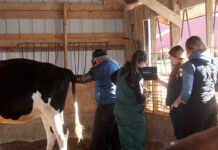WASHINGTON – The pork producer members of the National Pork Board approved the 2003 Pork checkoff program budget and forwarded their plans to the U.S. Department of Agriculture for final approval.
The plans are based on a checkoff revenue forecast of $42 million, which is 12.5 percent lower than this year.
“We focused on planning and funding programs that offer the best return on the investment pork producers make in the checkoff every time we sell hogs and pigs,” explained David Culbertson, a pork producer from Geneseo, Ill., and chairman of the Pork checkoff Plan of Work and Budget Task Force.
“There are exciting program opportunities for pork producers through the Pork checkoff – some to drive consumer demand and some that improve our farm production – all directed to our benefit.”
Pork checkoff funds can only be used for promotion, consumer information, research and education.
At the national level, promotions planned in 2003 will focus on ham, barbecue and Hispanic marketing. Consumer information also will highlight these areas, as well as continue to spread the news that pork is part of a healthy diet.
Grants. Through a competitive grants program, the nation’s top researchers will vie for checkoff funds for research projects that will be selected based on priorities set by producer committees.
The focus in 2003 will be on antimicrobial use and alternatives, animal care and welfare, swine health, environment/on-farm and pre-harvest pork safety.
The education program will focus on taking this research information to producers and applying it to their farms.
New emphasis. A new area of emphasis for national checkoff spending is the development of distance education programs.
During 2003, these plans should result in new opportunities for pork producers to learn about environment and production management techniques without having to travel far from their homes or farms.
Because pork producers have asked for more communication about their checkoff investment, the budget is increased for communications and producer relations, which includes the Producer Service Center.
“Since the Producer Service Center started in 2002, the response from pork producers for the Pork checkoff’s Producer Service Center has been fantastic. The number of pork producers calling 800-456-PORK continues to increase,” Culbertson said.
“Producers can call to give input or to get questions answered about pork production.”
Also, the service center is used to call producers, informing them of local meetings where checkoff information is shared or where they can provide their input.
The center is one way that producer leaders involved in the planning and budgeting process heard of ideas for programs to fund through the checkoff. Also, pork producers can share ideas in person at local, state and national meetings held throughout the year.
“We have 15 producer members of the Pork Board from 13 states and producer leaders in 44 state associations who can and will take any producer input,” Culbertson said.
Funding decreases. Although pork producers are recommending increased checkoff spending in some areas, they also are recommending decreases in many areas.
The national human nutrition and post-harvest pork quality programs ended in 2002 due to changes in producer priorities.
The total 2003 checkoff spending estimate is $49 million, with $40.1 million for national programs and $8.9 million for state and local programs. Plans for national spending include using more than $6 million from reserves.
Of checkoff revenue to be gathered in 2003, 80 percent will stay at the national level and 20 percent will be returned to states for state and local programs, according to the percentage determined by pork producers during their annual meeting.
The combined national and state checkoff budget for 2003 directs 60 percent of the pork checkoff spending for promotion, 26 percent research and 14 percent consumer information.
Allocations. Some programs are more effective or efficient at either the national or state level. Because of that, the budgets are allocated differently.
At the national level, the pork checkoff budget is 68 percent promotion, 24 percent research and 7 percent consumer information.
At the state level, the pork checkoff budget is 37 percent consumer information, 33 percent promotion and 30 percent research.
National Pork Board has responsibility for checkoff-funded research, promotion and consumer information projects and for communicating with pork producers and the public. Through a legislative national pork checkoff, pork producers invest 40 cents for each $100 value of hogs sold.
The pork checkoff funds national and state programs in advertising, consumer information, retail and foodservice marketing, export market promotion, production improvement, technology, swine health and pork safety.









